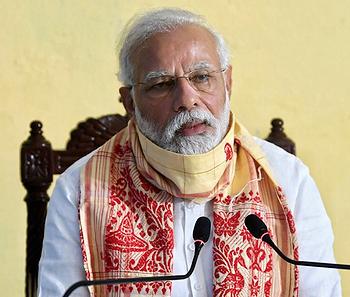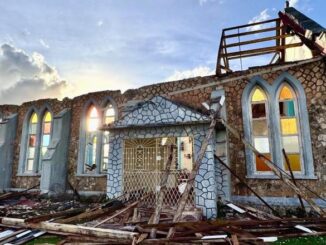
DELHI, India, May 22, 2020 (ENS) – At least 102 people have lost their lives as the intense cyclone Amphan slammed into India and Bangladesh on Wednesday and Thursday, smashing thousands of homes and flooding low-lying areas with torrential rain. As the storm made landfall on Wednesday evening, local time, roughly 4.2 million people were evacuated in coastal India and Bangladesh, with about two million from India and 2.2 million from Bangladesh.
Most of the evacuations in India occurred in the state of West Bengal. Over a million people evacuated from areas near the Bangladesh–India border.
At least 77 deaths were reported in India and 25 others in Bangladesh, according to the European Union’s Directorate-General for European Civil Protection and Humanitarian Aid Operations.
The death toll is expected to rise as rescuers make their way into the hardest-hit areas, including the remote islands close to the Sundarbans National Park, an area of mangrove forests and critical tiger habitat in the delta spanning the India-Bangladesh border.

Today, India’s Prime Minister Narendra Modi in a meeting with his top officials explained how the country is caught between two gigantic disasters.
“The world is fighting a war to save lives from the coronavirus on one side. In the hour of such a crisis – be it the central government or the state governments – all the departments and all the citizens have been engaged in the fight against coronavirus for the last two-and-a-half months,” Modi said. “At such a time, another major crisis in the form of a cyclone – a Super-Cyclone – was a matter of great concern.”
Modi today visited the two states hardest hit by the storm, West Bengal and Odisha. He offered condolences and funding to the next of kin of the dead and more funding to those seriously injured in the cyclone.
Modi also announced initial disaster relief funding to the two states pending further damage assessments.
Pandemic constraints on shelters in Bangladesh prompted deputy commissioners in 19 coastal districts to seize educational institutions and mosques for use as shelters. More than 12,000 shelters were opened across Bangladesh, with the capacity to house 5.19 million evacuees. They are being supplied with food and emergency cash from the Bangladeshi Ministry of Disaster Management and Relief.
“It is believed that around 10 million people in Bangladesh are impacted by the cyclone, with half a million families potentially having lost their homes,” UN Spokesperson Stéphane Dujarric told reporters during a regular virtual briefing on Thursday, from New York.
Over three million people in both countries continue to remain in community shelters. Shelters could be filled only to one-third capacity to maintain social distancing guidelines due to the coronavirus pandemic. Social distancing restrictions in West Bengal reduced evacuation capacity in shelters from 500,000 people to just 200,000 people.
The first tropical cyclone of the 2020 North Indian Ocean cyclone season, Amphan caused the greatest damage in the Indian state of West Bengal, which includes the city of Kolkata [formerly Calcutta] and many coastal fishing villages where people live in huts of mud and sticks.
Extensive damage to thatched homes, crops and gardens, and fisheries has been reported. The storm downed power and telecommunication lines, and most areas remain without electricity or communication networks. Roads blocked by debris are limiting a rapid response.
Still, the EU is determined to start helping people in need with no further delay and provides initial funding of €500,000 for India and €1.1 million to support the immediate response in Bangladesh.

Tropical Cyclone Amphun formed out in the Bay of Bengal on May 16. Two days later, Amphun had intensified to a category 5 storm with sustained winds of 265 kilometers (165 miles) per hour as it churned over the Bay of Bengal. Amphun and other cyclones in the North Indian Ocean with winds surpassing 220 kilometers (140 miles) per hour are considered “super cyclonic,” the highest classification in the basin.
Amphun made landfall between Digha, West Bengal and the Hatiya Islands in Bangladesh on Wednesday, May 20 as a category 3 storm carrying strong winds up to 185 km/h (115 mph) and torrential rain, damaging houses, crops and cutting power supplies to cities, towns and villages already struggling to contain the coronavirus outbreak.
Winds decreased as Amphan moved north-northeast over land, but the storm remained strong enough to destroy buildings, uproot trees and crops, and down powerlines. The winds pushed up a 5-meter (16-foot) storm surge that flooded coastal areas.
Amphun caused very heavy rainfall over West Bengal and Sikkim on Wednesday and Thursday and struck the Indian states of Assam and Meghalaya on Thursday. Meghalaya, a hilly state in India’s northeast was already the country’s wettest region.
Authorities said it is still too early to know the full damage or the final death toll from the storm. Many areas are still inaccessible because a maze of broken trees and live electric wires lies sprawled across the roads.
But with only initial damage estimates reported, Amphan is already being named the costliest cyclone ever recorded in the North Indian Ocean, causing over US$13 billion of damage to date.
Mamata Banerjee, chief minister for India’s West Bengal state, said on Friday that damages in West Bengal are equivalent to about US$13 billion, the “Hindustan Times” newspaper reported.
On a positive note, the Bangladesh Meteorological Department for the first time introduced regular storm surge forecasts, due to work carried out by the World Meteorological Organization’s Coastal Inundation Forecasting project funded by USAID.
Copyright Environment News Service (ENS) 2020. All rights reserved.
© 2020, Environment News Service. All rights reserved. Content may be quoted only with proper attribution and a direct link to the original article. Full reproduction is prohibited.



